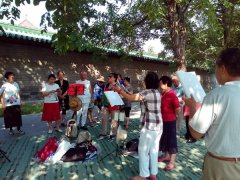Xinhua Insight: Old meets new on Beijing's historic axis
by Xinhua writers Liu Xin, Kong Xiangxin
BEIJING, Sept. 29 (Xinhua) -- The north-south axis of China's ancient capital has been extended and revitalized.
On Sept. 29, Beijing authorities unveiled a general plan for the development of the central axis, called the Zhongzhouxian, from 2016 to 2035. It aims to protect the city's history and culture.
The plan said the Zhongzhouxian is both historical and developing, and preservation work should be coordinated with upgrades.
First created in the Yuan Dynasty (1271-1368), the original Zhongzhouxian was 3.7 kilometers. The Ming (1368-1644) and Qing (1644-1911) dynasties extended the length to 7.8 kilometers from Yongdingmen in the south to the Drum and Bell Towers in the north.
Chinese architect Liang Sicheng, a pioneer of heritage preservation, described the Zhongzhouxian as possibly the world's longest and greatest north-south central axis.
"The unique beauty of Beijing's design is due to the Zhongzhouxian," declared Liang.
The axis was extended again in 2003 as the city prepared for the 2008 Olympic Games.
The general plan states that the current Zhongzhouxian extension stretches to the Yanshan Mountain Range to the north and Beijing's new international airport in the south.
The Olympic Green is considered one of the most important areas along the Zhongzhouxian extension.
Zhao Jin, operations director of Beijing Inno-Olympic Group Co., Ltd., which is leading the Olympic Green property management, says the China Intangible Cultural Heritage Hall and the National Art Museum of China will be built along the Zhongzhouxian extension.
"Together with the Bird's Nest, Water Cube, and China National Convention Center, the north extension is expected to be a national hub for culture, sports, technology and finance," he said.
The Olympic Green received a total of 410 million people, including tourists and visitors, from 2008 to 2016, according to Zhao.
The extension is not separated from the original axis. On a clear day, from the top of Yangshan Mountain in Olympic Park, it is possible to see 8 km south to Jingshan, the highest point on the original Zhongzhouxian.
The Zhongzhouxian, situated at the city's center, separates the districts of Dongcheng and Xicheng.
"It is like the backbone of Beijing's urban spacial structure," said Beijing historian Li Jianping.
Along it are the historic buildings of Qianmen, the Forbidden City, Jingshan Park, and the Drum and Bell Towers.
Political monuments such as Chairman Mao Zedong Memorial Hall, the Monument to the People's Heroes and Tian'anmen Square line up along the axis.
"This reflects the Chinese idea of 'center worship,'" said Li.
The symmetry is maintained along the Zhongzhouxian. The Great Hall of the People and Beijing Zhongshan Park are on the west side, while the National Museum of China and Beijing Working People's Cultural Palace are on the east.
Beijing Zhongshan Park used to be the Hall of Worshipping the Altar of Land and Grain, which was built in 1425. The Beijing Working People's Cultural Palace was the royal ancestral temple before the founding of the People's Republic of China in 1949.
In 1949, a founding ceremony was held in Tian'anmen Square, transforming it into a place for the people rather than royalty.
The construction of the Bird's Nest and the Water Cube on each side of the Zhongzhouxian north extension reflects the symmetry found along older parts of the axis.
"Beijing has been built according to a 'checker-board' planning system since the Yuan Dynasty," explained Wang Shiren of the city's history and culture preservation committee. "Meanwhile, many capitals of other countries had 'divergent' structures influenced by the Renaissance."
The Beijing Municipal government officially kicked off a campaign in 2011 to place main historic sites along the city's central north-south axis on the world cultural heritage list.
Wang says the Zhongzhouxian used to have 42 historic sites, and 36 of them have been preserved or rebuilt.
But there have also been criticisms of excessive renovation along the axis. Its original south end at Yongdingmen Tower was rebuilt in 2004.
Feng Feifei, director of the Urban Design Department of Beijing Municipal Institute of City Planning and Design, said the city went through different historical periods in which different things were valued.
"The urban functions also differed," she said.
For this reason, a number of historical influences are visible along the axis, including the culture of old Beijing on the section between Yongdingmen and Qianmen, the culture of New China between Mao Zedong Memorial Hall and Tian'anmen, and the imperial culture of the Ming and Qing dynasties from Duanmen to Jingshan Park, Li Jianping said.
The city aims to make progress in becoming a top international capital over the next five years, according to the city's new development goals unveiled in June.
The capital is striving to improve as the country's political, cultural, international and innovation center.
"A long history means a rich cultural heritage," Feng said. Enditem (Ji Xiang and Zhang Lili contributed to the story.)















